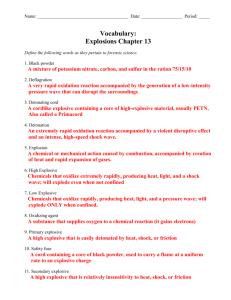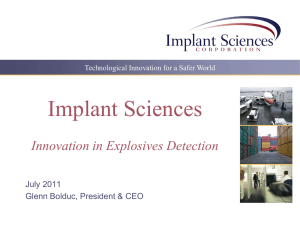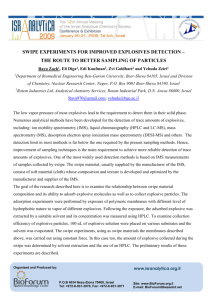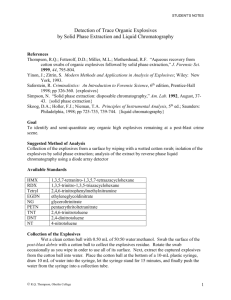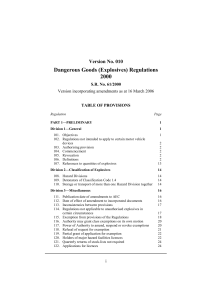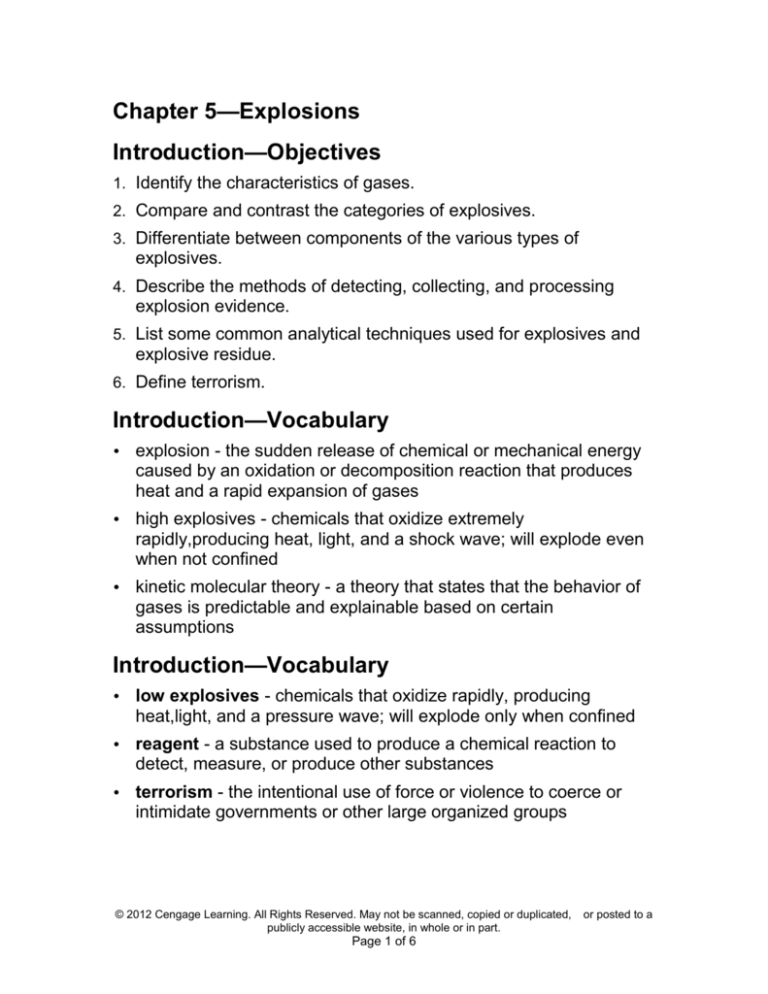
Chapter 5—Explosions
Introduction—Objectives
1. Identify the characteristics of gases.
2. Compare and contrast the categories of explosives.
3. Differentiate between components of the various types of
explosives.
4. Describe the methods of detecting, collecting, and processing
explosion evidence.
5. List some common analytical techniques used for explosives and
explosive residue.
6. Define terrorism.
Introduction—Vocabulary
explosion - the sudden release of chemical or mechanical energy
caused by an oxidation or decomposition reaction that produces
heat and a rapid expansion of gases
high explosives - chemicals that oxidize extremely
rapidly,producing heat, light, and a shock wave; will explode even
when not confined
kinetic molecular theory - a theory that states that the behavior of
gases is predictable and explainable based on certain
assumptions
Introduction—Vocabulary
low explosives - chemicals that oxidize rapidly, producing
heat,light, and a pressure wave; will explode only when confined
reagent - a substance used to produce a chemical reaction to
detect, measure, or produce other substances
terrorism - the intentional use of force or violence to coerce or
intimidate governments or other large organized groups
© 2012 Cengage Learning. All Rights Reserved. May not be scanned, copied or duplicated, or posted to a
publicly accessible website, in whole or in part.
Page 1 of 6
Timothy McVeigh
April 19, 1995—Timothy McVeigh loaded a rental truck with
ammonium-nitrate fertilizer and other chemicals.
When detonated, the explosion demolished one-third of the 7-story
Murrah Federal Bldg.
70 people died, including 19 children.
The FBI created a criminal profile.
How was Timothy found and convicted?
Introduction to Explosions
Like fire
Caused by a chemical reaction—either by
•
•
Oxidation—two substances combine to form a new substance
Decomposition—a single compound breaks down
A large amount of gas and energy is released very quickly
Properties of Gas (Obj 5.1)
Kinetic Molecular Theory
the behavior of gases is predictable
Gases are made up of rapidly and randomly moving particles
Most of the volume of a gas is empty space. Why?
When a gas particle collides with the container or with other
particles, there is no net loss of energy.
The average kinetic energy is directly proportional to the
temperature of the gas.
There is no force of attraction between gas particles or between
the particles and the walls of the container.
Properties of Gas
Combined Gas Law—an equation that describes the relationship
among volume, temperature, and pressure in confined gases.
© 2012 Cengage Learning. All Rights Reserved. May not be scanned, copied or duplicated, or posted to a
publicly accessible website, in whole or in part.
Page 2 of 6
Characteristics of an Explosion (Obj 5.2)
Wave—a disturbance in matter that carries energy
Longitudinal wave—a pressure wave
•
•
Compressions
Rarefactions
Shrapnel
Low Explosives (Obj 5.2, 5.3)
Materials that burn rapidly but explode only when confined in a
container
Deflagration—the resulting combustion reaction
•
•
Rapid, intense burning
Pressure waves at less than 340 meters / sec.
Often used as propellants, such as a bullet
High Explosives (Obj 5.2, 5.3)
Materials that
•
•
•
Detonates easily
Produces pressure waves to 8500 meters / sec.
Shock wave moves faster than speed of sound
Detonation—an explosion that causes violent disruption to the
surrounding area
High Explosives
Primary High Explosives
•
•
•
Extremely sensitive to heat, pressure, and movement
Usually too volatile for most uses
Nitroglycerin
Secondary High Explosives
•
•
•
Less sensitive
Often used for military and commercial purposes
TNT and dynamite
Fireworks
© 2012 Cengage Learning. All Rights Reserved. May not be scanned, copied or duplicated, or posted to a
publicly accessible website, in whole or in part.
Page 3 of 6
Collecting Evidence (Obj 5.4)
Collect
•
•
•
•
•
•
•
•
Soil samples
Debris from inside
the crater
Traces of explosive
residue
Detonating devices
Other pieces of the
explosive device
Microscopic Examination (Obj 5.5)
Low-power stereomicroscopy
Examine the debris for unexploded material
Color Spot Tests (Obj 5.5)
Reagent—a substance used to produce a chemical reaction to
detect, measure, or produce other substances
Modified Griess Test—detects presence of nitrate compounds
Diphenylamine Test—detects most explosive residues, but not
TNT
Alcoholic potassium hydroxide (KOH)— detects TNT
Color Spot Tests
Chromatography
(Obj 5.5)
Thin Layer Chromatography (TLC)
•
•
•
Presumptive test for explosives
Rf values from TLC provide tentative identification of the components of the
mixture
A cellulose or silica gel plate as the stationary phase
© 2012 Cengage Learning. All Rights Reserved. May not be scanned, copied or duplicated, or posted to a
publicly accessible website, in whole or in part.
Page 4 of 6
Confirmatory Tests (Obj 5.5)
Infrared spectroscopy
•
•
A beam of infrared light passes through a sample
Measure how much energy is absorbed
Gas chromatography-mass spectroscopy
•
•
Gas chromatography separates a substance into its compounds
Mass spectroscopy breaks down the compounds into smaller charged
particles and separates them based on their mass and charge
Examining Physical Evidence (Obj 5.5)
Examples:
Pieces of wire
Pieces of pipe
Detonation devices
Fingerprints
Residue on clothes
Timing devices
Terrorism
The intentional us of force or violence to coerce or intimidate
governments or other organized groups.
Groups or individuals
Common reasons
•
•
•
Political
Environmental
Religious
Chapter Summary
An explosion is an oxidation or decomposition reaction that
releases a lot of gas and energy very quickly.
Knowledge of the kinetic molecular theory is important in the
investigation of explosions.
Low explosives burn rapidly but explode only when confined. The
burning of a low explosive is called deflagration.
© 2012 Cengage Learning. All Rights Reserved. May not be scanned, copied or duplicated, or posted to a
publicly accessible website, in whole or in part.
Page 5 of 6
Chapter Summary
High explosives can explode even when they are not confined,
causing a violent disruption.
Primary high explosives, such as nitroglycerin, are extremely
sensitive to heat, pressure, and movement.
Secondary high explosives are not as sensitive to heat or shock,
but are capable of violent explosions. These are typically used by
the military or for mining or construction.
Investigators collect soil samples and debris from an explosion’s
point of origin. They search for explosive residue, pieces of the
explosive device, or detonating devices.
The crime lab examines evidence under a stereomicroscope.
The crime lab can also wash the debris with acetone to dissolve
the explosives and then analyze it to identify the type of explosive.
Thin layer chromatography is a presumptive test to provide a
preliminary identification.
Forensic scientists then perform confirmatory tests, such as
infrared spectroscopy and gas chromatography–mass
spectroscopy.
Explosions are often caused by acts of terrorism. Terrorism may
be politically, environmentally, or religiously motivated.
© 2012 Cengage Learning. All Rights Reserved. May not be scanned, copied or duplicated, or posted to a
publicly accessible website, in whole or in part.
Page 6 of 6


